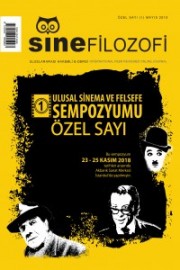Köpek Dişi Ya Da “Mülklerin En Tehlikelisi” Olarak Dil
Dogtooth or the Language as “the Most Dangerous of Goods”
Author(s): Güven ÖzdoyranSubject(s): Philosophy of Language, Psychoanalysis, Evaluation research, Film / Cinema / Cinematography
Published by: Serdar Öztürk
Keywords: Lanthimos; Dogtooth; Lacan; Language; Psychoanalysis; Symbolic Order;
Summary/Abstract: The aim of philosophy, for Wittgenstein, is to show the way out to the fly trapped in the bottle. According to him, metaphysics and the fly’s “false-consciousness” are of the same kind. The fly inside the bottle speaks falsely about “the bottle” (the world) as if it were looking from the outside of the bottle. Cinema with the power to produce images, unlike the eye as a body-dependent position, has the ability to show the bottle from outside. Yorgos Lanthimos’ Dogtooth (Kynodontas) creates a world that allows us to look at the bottle we live in with a meta-view. Contrary to common belief, Dogtooth is not the story of an abnormal, pathological family. In fact, it reveals the codes that cover the abnormalities in the society, constructed through the language, we live in. It is, indeed, the story of all of us which is told in the film. In this context, Lacanian psychoanalysis and Lacan’s way of understanding the language and society provide audiences with a powerful tool for analyzing the film. With the Lacanian strategy, the film does not tell us what the real is, because the real is unexplainable. It shows us what the real is not. The main claim of this paper is the idea that Lacan’s Symbolic Order and the world established in Dogtooth extremely intersect. In this study, Lanthimos’ film will be analyzed by putting the Lacanian paradigm at the center and the central role of the language in the process of constructing our reality will be discussed.
Journal: SineFilozofi
- Issue Year: 4/2019
- Issue No: Sp. Iss
- Page Range: 605-622
- Page Count: 18
- Language: Turkish

